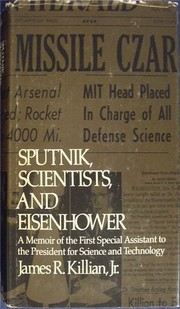Check nearby libraries
Buy this book

When the Soviet Union orbited Sputnik I, the world's first man-made satellite, on October 4, 1957, shock waves from the event were felt throughout the United States. The reactions ranged from mindless, uninformed panic to deeply thoughtful questionings of the structure of American science, technology, and national security and the goals and values of American education. Recognizing the dimensions of the crisis, President Eisenhower made immediate moves to reassure the American people. One of his first acts was to bring a science advisory capability into the White House itself, to serve the president directly. Toward the end of an address to the nation, delivered on November 7, 1956, Eisenhower spoke as follows:
"As to action: I report the following items to you tonight.
"The first thing I have done is to make sure that the very best thought and advice that the scientific community can supply, hitherto provided to me on an informal basis, is now fully organized and formalized so that no gap may occur. The purpose is to make it possible for me, personally, whenever there appears to be any delay in our development system, to act promptly and decisively.
"To that end, I have created a new office, called the office of Special Assistant to the President for Science and Technology. This man, who will be aided by a staff of scientists and a strong advisory group of outstanding experts reporting to him and to me, will have the active responsibility of helping me follow through on the program of scientific improvement of our defenses.
"I am glad to be able to tell you that position has been accepted by Dr. James R. Killian, President of the Massachusetts Institute of Technology. He is a man who enjoys my confidence, and the confidence of his colleagues in the scientific and engineering world, and in the government.
"Through him, I intend to be assured that the entire program is carried forward in closely integrated fashion...."
This was not the first time James Killian had been called on by presidents to serve his country, nor was it to be the last. Truman had appointed him a member of the Science Advisory Committee of the Office of Defense Mobilization in 1951. He had directed the secret Technological Capabilities Panel (or Surprise Attack Panel) for Eisenhower in 1954-1955, which prepared careful assessments of relative U.S. and Soviet military strengths. He chaired the President's Board of Consultants on Foreign Intelligence Activities for both Eisenhower and Kennedy. And his counsel to Ford and to Congress was influential in the restoration of a science advisor to the White House after the discontinuance of the office during the Nixon years.
In this personal memoir, Killian recounts his activities in these and other posts. He conducts the reader on a guided tour through corridors of power in the White House that are not often opened to the public. Candid portraits of national leaders and behind-the-scenes, almost anonymous manipulators of the levers of policy are included. The book represents narrative accounts, based on the author's recollection of his first-hand participation and on newly declassified documents in the Eisenhower Library, of the beginnings of the U.S. space program and the founding of NASA, the ongoing development of the intercontinental ballistic missile and other weapons systems, and the reopening with the Soviet Union of discussions on limiting nuclear tests and other arms-control initiatives. Clearly, the issues that underlie these events are as pertinent today as they were then, and Killian brings his experience to bear on current problems that parallel those he dealt with at the White House. [Amazon]
Check nearby libraries
Buy this book

Previews available in: English
Subjects
Sources, Science and state, Technology and state, HistoryPlaces
United StatesShowing 1 featured edition. View all 1 editions?
| Edition | Availability |
|---|---|
|
1
Sputnik, scientists, and Eisenhower: a memoir of the first special assistant to the President for science and technology
1977, MIT Press
in English
0262110660 9780262110662
|
aaaa
Libraries near you:
WorldCat
|
Book Details
Published in
Cambridge, Mass
Table of Contents
Edition Notes
Bibliography: p. [303]-305.
Includes index.
Classifications
The Physical Object
ID Numbers
Community Reviews (0)
Feedback?| February 13, 2020 | Edited by MARC Bot | remove fake subjects |
| July 22, 2017 | Edited by Mek | adding subject: In library |
| September 28, 2016 | Edited by contulmmiv | Added new cover |
| September 27, 2016 | Edited by contulmmiv | Added description |
| December 10, 2009 | Created by WorkBot | add works page |









